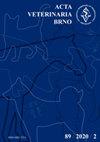Effect of Tarantula cubensis alcoholic extract on tumour pathways in azoxymethane-induced colorectal cancer in rats
IF 0.7
4区 农林科学
Q3 VETERINARY SCIENCES
引用次数: 4
Abstract
The aim of this study was to determine the effects of Tarantula cubensis alcoholic extract (TCAE) on tumour development pathways in azoxymethane (AOM)-induced colorectal cancer in rats by molecular methods. Eighteen paraffin-embedded intestinal tissues, six from each group, were studied in the healthy control (C), cancer control (CC), cancer + TCAE (C-TCAE) groups. Sections of 5 µm thickness were taken from the paraffin blocks and submitted to staining with haematoxylin-eosin. In the histopathological examination, the number of crypts forming aberrant crypt foci (ACF) and the degree of dysplasia in the crypts were scored. Real-time PCR analysis was completed to determine β-catenin, KRAS (Kirsten rat sarcoma virus), APC (adenomatous polyposis coli) and P53 expressions on samples from each paraffin block. The grading scores of the number of crypts forming ACF and dysplasia in the crypts showed an evident decrease in the C-TCAE group in comparison to the CC group (P < 0.05). In real-time PCR analysis, mRNA expression levels of P53 (P > 0.05) and APC (P < 0.001) genes were found to be increased in the C-TCAE group according to the CC group. The expression levels of KRAS (P < 0.01) and β-catenin (P < 0.005) mRNA were found significantly decreased in the C-TCAE group. In conclusion, the effects of TCAE on AOM-induced colorectal cancer (CRC) in rats were evaluated molecularly; TCAE was found to modulate some changes in CRC developmental pathways, inhibiting tumour development and proliferation, and stimulating non-mutagenic tumour suppressor genes. Thus, it can be stated that TCAE is an effective chemopreventive agent.狼蛛酒精提取物对偶氮甲烷诱导大鼠结直肠癌肿瘤通路的影响
本研究旨在通过分子方法研究狼蛛酒精提取物(TCAE)对偶氮氧甲烷(AOM)诱导的大鼠结直肠癌肿瘤发展途径的影响。选取健康对照组(C)、癌对照组(CC)、癌+ TCAE (C-TCAE)组18个石蜡包埋肠组织,每组6个。从石蜡块上取厚度为5µm的切片,用苏木精-伊红染色。在组织病理学检查中,对形成异常隐窝灶(ACF)的隐窝数量和隐窝发育不良程度进行评分。Real-time PCR检测每个石蜡块样品中β-catenin、KRAS (Kirsten大鼠肉瘤病毒)、APC(大肠腺瘤性息肉病)和P53的表达。C-TCAE组形成ACF的隐窝数评分及隐窝发育不良评分较CC组明显降低(P < 0.05)。real-time PCR结果显示,C-TCAE组P53基因(P < 0.05)和APC基因(P < 0.001) mRNA表达水平与CC组比较明显升高。C-TCAE组KRAS (P < 0.01)和β-catenin (P < 0.005) mRNA表达量显著降低。综上所述,从分子角度评价了TCAE对aom诱导的大鼠结直肠癌(CRC)的作用;研究发现,TCAE可调节结直肠癌发展途径的某些变化,抑制肿瘤的发展和增殖,并刺激非致突变的肿瘤抑制基因。因此,可以说TCAE是一种有效的化学预防剂。
本文章由计算机程序翻译,如有差异,请以英文原文为准。
求助全文
约1分钟内获得全文
求助全文
来源期刊

Acta Veterinaria Brno
农林科学-兽医学
CiteScore
1.00
自引率
33.30%
发文量
36
审稿时长
18-36 weeks
期刊介绍:
ACTA VETERINARIA BRNO is a scientific journal of the University of Veterinary and Pharmaceutical Sciences in Brno, Czech Republic.
The scientific journal Acta Veterinaria Brno is dedicated to the publication of original research findings and clinical observations in veterinary and biomedical sciences. Original scientific research articles reporting new and substantial contribution to veterinary science and original methods that have not been submitted for publication elsewhere are considered for publication. A written statement to this effect should accompany the manuscript, along with approval for publication by the author´s head of department. The authors bear full responsibility for the contents of their contribution. Book reviews are published, too.
 求助内容:
求助内容: 应助结果提醒方式:
应助结果提醒方式:


